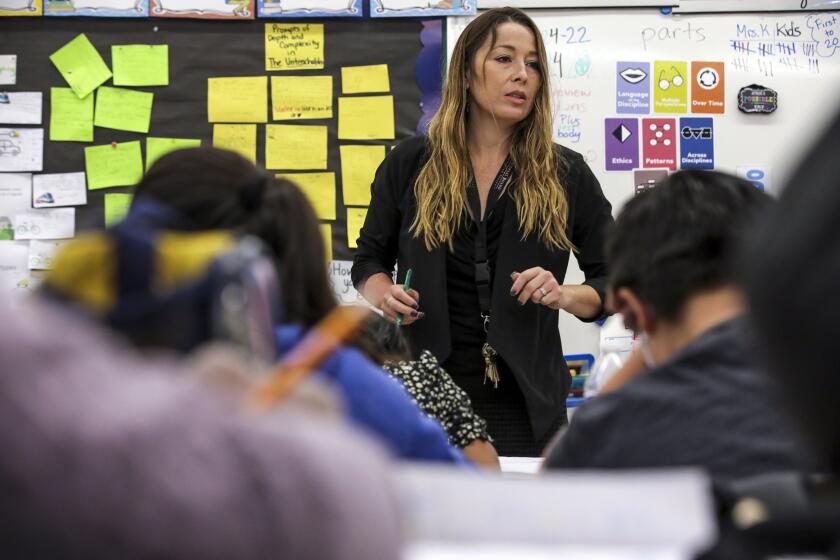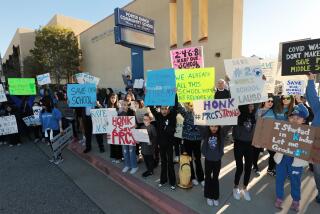Will California’s $4.1-billion bet on ‘community schools’ transform K-12 education?
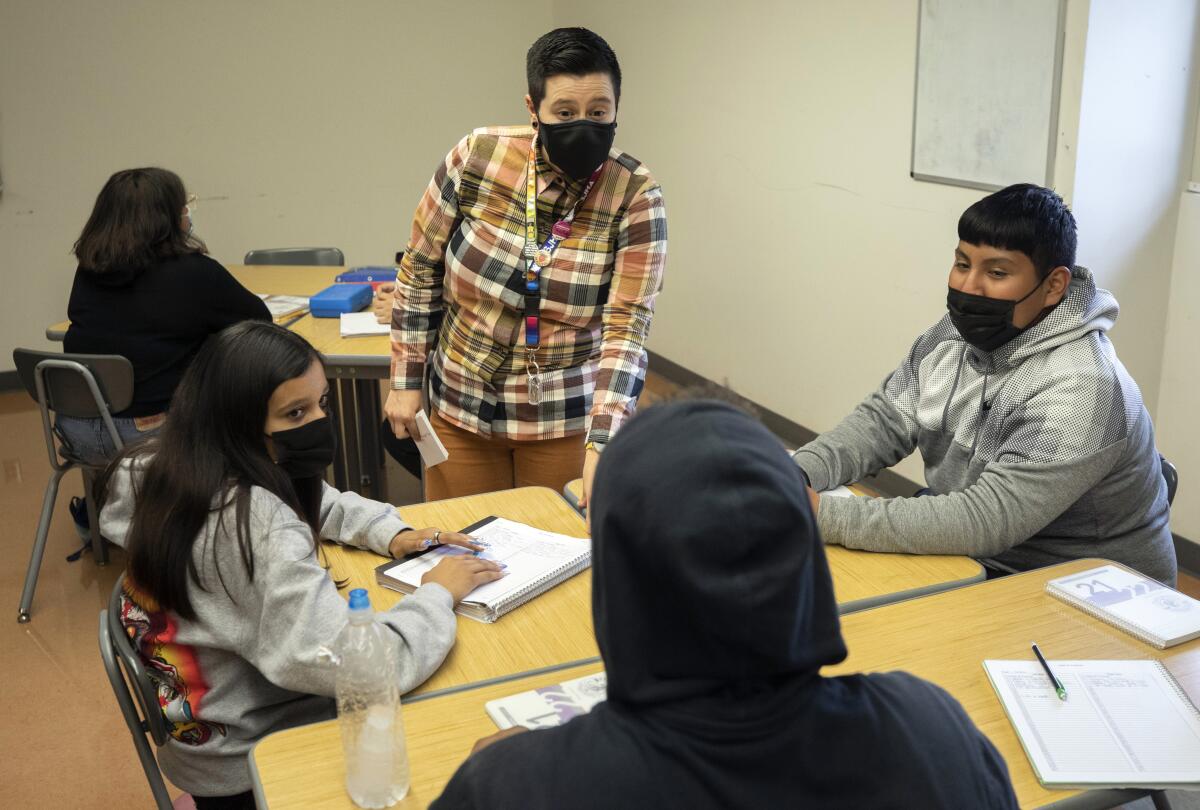
When students returned to the Social Justice Humanitas Academy campus in August 2021, many could barely focus on their high school assignments. They walked out of class. They refused to do work. Drug use and the number of students hospitalized because of suicidal thoughts were on an alarming incline.
Teachers and staff at Humanitas saw the crisis before them — and turned to their long-established playbook for solutions.
“Our philosophy is to meet kids where they’re at,” Principal Jeffrey Austin said, “and take them far as we possibly can.”
Teachers led group discussions about how hard it had been to be separated from friends for 16 months. They focused instruction on addressing learning gaps, even if it meant students were not on track to meet state standards. Teachers called parents regularly and learned of lost jobs and lost loved ones. Many students missed class because they were working, so the school shifted class schedules to accommodate them.
By the end of the school year, students were staying in class and drug use declined, Austin said. Graduation rates at the Los Angeles Unified school in San Fernando remained high, just shy of 100%.
Humanitas’ strength is rooted in its 11-year stature as a “community school” — a model that could take hold at many more California K-12 campuses in the coming years. California is making a mega-bet — with an unprecedented $4.1-billion investment over seven years — that converting hundreds of campuses in high-poverty neighborhoods into schools like Humanitas offers the best chance to save children’s pandemic-damaged education and address entrenched inequities.
This plan dramatically expands the traditional definition of a public school, overhauling campuses into neighborhood centers that seek to comprehensively meet the needs of students. Healthcare, mental health services, tutoring, pediatric care and other social supports converge on campus. Teachers and staff strive to make learning more culturally relevant and to foster a climate in which students have a sense of belonging and parents are a part of decision-making.

Community schools have lofty aspirations to topple barriers that prevent students from learning, such as hunger, anxiety and depression, racism and housing insecurity. Advocates say community schools could vastly improve educational outcomes at a time of declining enrollment, a youth mental health crisis and intensified learning deficits brought on by long, pandemic-forced school closures.
This is the dream, at least. The challenge is pulling it off.
This high-cost experiment is no quick fix, experts say. As waves of exhausted educators leave the profession amid the pressures of dealing with the most intense student needs in a generation, will school staff have the stamina to do the ambitious planning and work to establish the community school stronghold?
“It’s an important moment, and a serious moment, with this amount of money,” said Deanna Niebuhr, California policy director for the Opportunity Institute who has worked to establish community schools. “It’s not clear that this will work. But we believe it’s our best chance for real change in education.”
The advisory is to call attention to a “youth mental health crisis” and recommend resources to call on and actions to take.
In May, 268 districts across the state were awarded $649 million in grants — from $200,000 for schools in the early stages of planning to tens of millions for districts further along or seeking to expand. The L.A. Unified School District, which already has 31 community schools, received $44 million.
Gov. Gavin Newsom’s administration has dedicated $166 million to a network of at least five regional technical assistance centers, co-led by the Alameda County Office of Education and the UCLA Center for Community Schooling, that will guide districts and monitor progress.
There are relatively few schools nationwide that follow this robust model — an estimated 5,000, according to the Coalition for Community Schools. And though research is somewhat sparse, some studies have found that well-run community schools lead to better attendance, fewer discipline problems and chronic absences, and better communication with families.
“Good community schools recognize that even with all the support services, it is very unlikely that families who may have a distrust of public systems will access those services without the school first building a relationship with them,” said Hayin Kimner, a senior research fellow at Policy Analysis for California Education.
Humanitas: Their story
On paper, Jennie Rosenbaum’s job sounds clear-cut: She is a site coordinator, helping weave social-emotional learning into instruction and school culture. In practice, she’s a force on campus. She often works in the courtyard, a visible presence for when a student needs to speak with an adult. She strategizes with counselors and brings staff and students together to raise issues about what’s needed at school. She searches for opportunities — like college access programs — for all students, not just those who have top grades or are the most outgoing.
Rosenbaum’s role illustrates another tenet of community schools: breaking down job-related silos that can prevent educators from working together to support students.
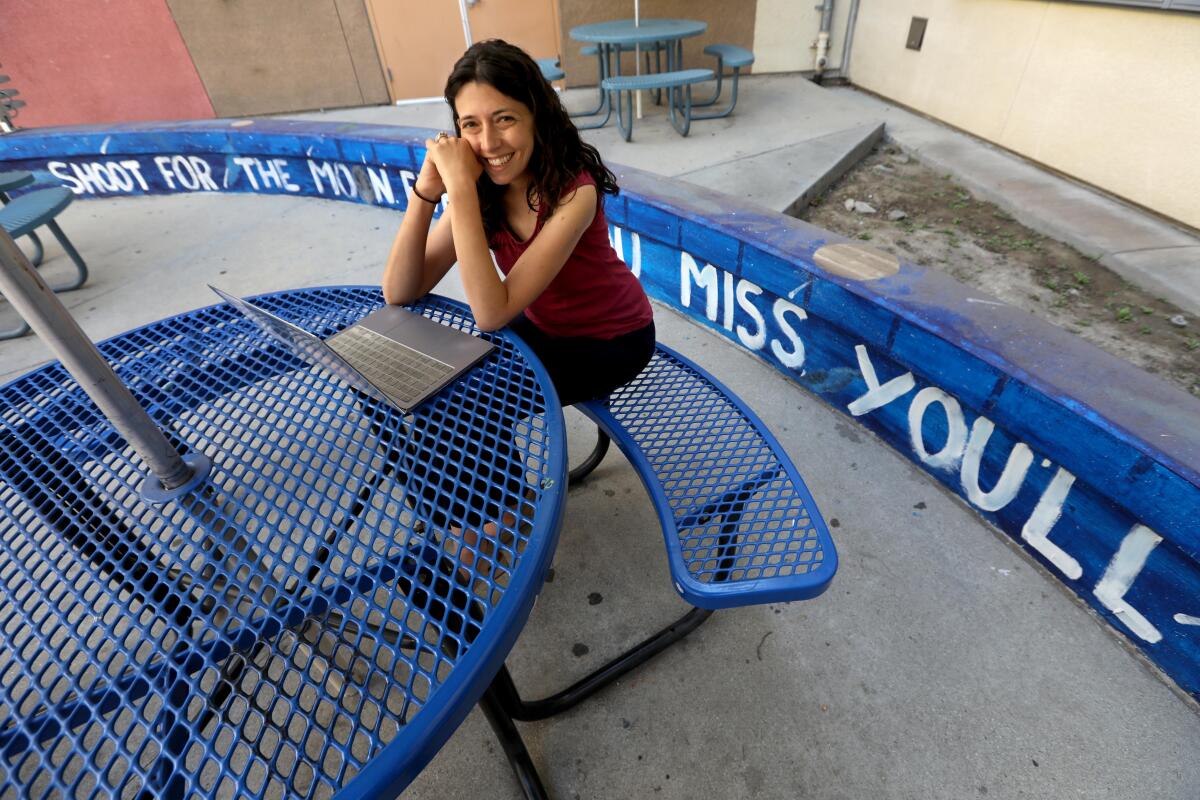

Once while helping a senior apply for college financial aid, Rosenbaum noticed how the girl, who had recently immigrated to the U.S., couldn’t focus enough to set up an account password. The student confided that her family had run out of food. Rosenbaum consoled the teen and spoke with a counselor who provided the girl with grocery store gift cards and ongoing emotional support.
“If you don’t have those strong relationships in place, the student isn’t going to share that they need help,” Rosenbaum said.
The school partners with EduCare, a nonprofit that connects the school to social service and funds Rosenbaum’s job. Organizations like Hathaway-Sycamores Child and Family Services provide individual, group and family therapy. Through these partnerships and others, the school has connected families with temporary shelter, food and legal assistance.
Every Humanitas student has a peer mentor, and each teacher “adopts” three or four pupils who are struggling academically or otherwise and checks in with them regularly.
One balmy afternoon last school year, math teacher Eugenia Plascencia fist-bumped and tapped elbows with ninth-graders as they entered her classroom, asking each how they were doing. The walls were covered with posters that quoted Malcolm X, celebrated being “unapologetically queer” and asserted that “Black Trans Lives Matter.”
If a student seems really tired or is being disruptive, Plascencia will privately ask, “What’s up? What do you need right now?”
“Instead of getting them into trouble, we get them support,” she said. Humanitas has made efforts to move away from punitive practices and toward restorative justice, which compels students to accept responsibility for their behavior and repair relationships with those they’ve hurt.
Humanitas — founded in 2011 by a group of Sylmar High teachers seeking to create a small autonomous campus within L.A. Unified — served 519 students in 2020-21, and all but a handful are Latino. Ninety-three percent were identified as economically disadvantaged. The school consistently outperforms its L.A. Unified counterparts.

On Common Core-aligned state assessments in 2019, 72% of students met or exceeded standards for English language arts, compared with the district average of 53%. Math scores have varied since 2015, ranging from 65% of students meeting or exceeding standards in 2014 to 40% in 2021. Still, Humanitas students surpassed the L.A. Unified average each of those years. Scores in all subjects dipped in 2021, when school was mainly virtual.
Johnny Martinez, a father of six, has been with Humanitas since its inception. His oldest son was part of the school’s first class of graduates, and his youngest is an upcoming 11th-grader. The Pacoima native is one of several parents serving on the governing council, where he votes on staffing and budget decisions. “They respect my point of view,” said Martinez, who runs a construction business.
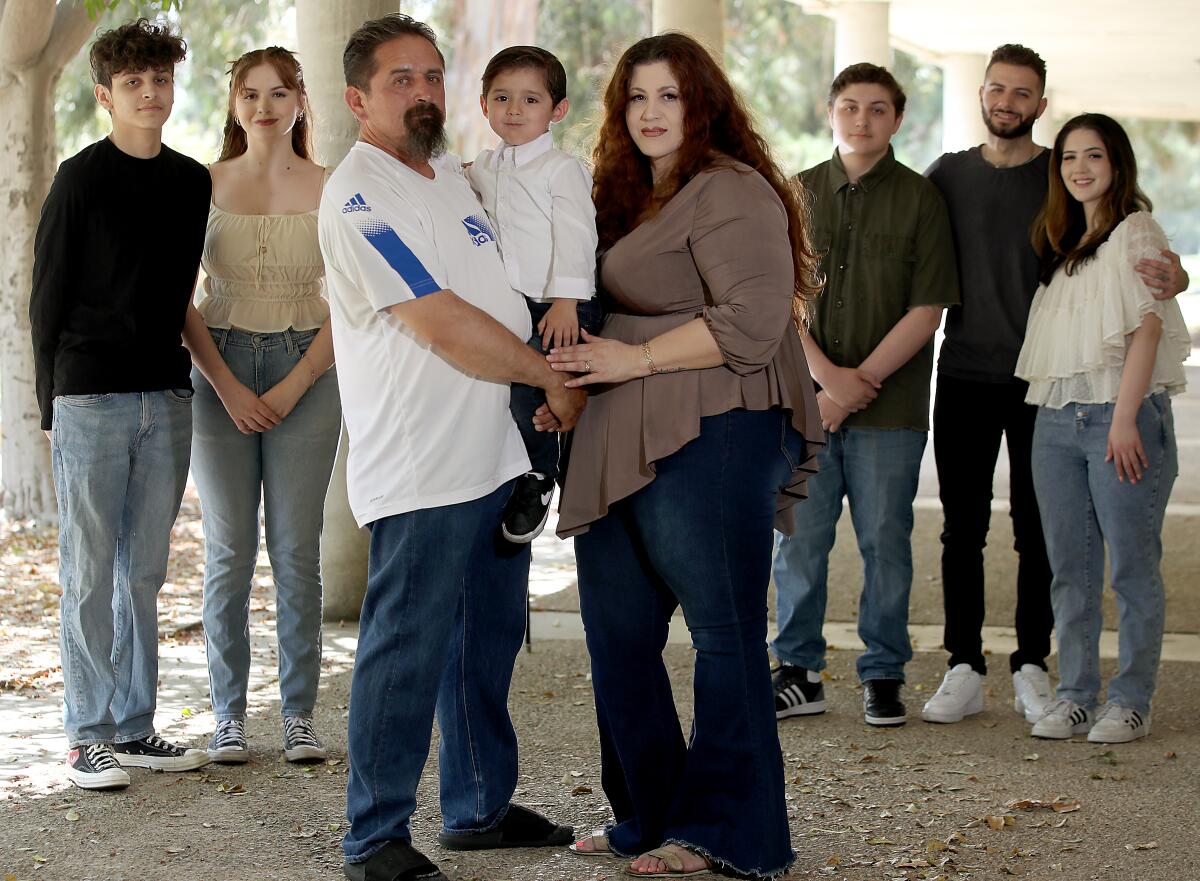
His Humanitas graduates have gone on to USC, Cal Poly and Cal State Northridge. He’s grateful that his kids went to a high school where teachers don’t give up on students.
“Around here, if you have big dreams and hopes for your kid, rumor has it that Humanitas is where you want to send them,” Martinez said.
What’s next?
Advocates caution that becoming a community school is a long-term commitment that may be difficult to sustain without well-coordinated funding.
In an ideal scenario, community schools cut down on social services costs by partnering with organizations that have access to other funding streams, Kimner said. But any financing strategy should consider districts in areas of the state with fewer health and human service organizations, said Alex Briscoe, head of the California Children’s Trust.
At Humanitas, services change yearly based on available state, federal and philanthropic funding. If a partnering organization’s grant runs out, or if it goes out business, staff must scramble to fill that gap. And they have to be scrappy; Humanitas is funded in the same way as other L.A. Unified schools, which requires “a lot of moving nickels and dimes around,” Austin said.
The ethos-driven aspects of the model may be harder to implement and measure, experts said. For example, how do you evaluate whether there are healthy relationships between staff and students?
In the pandemic’s latest hit on education, the number of L.A. Unified students who have been chronically absent this school year has doubled.
Ensuring that curriculum is culturally and linguistically relevant to students will be a heavy lift too, said Cora Watkins, director of L.A. Unified’s community schools initiative — and could require changes in teacher credentialing programs.
And all this comes amid pandemic burnout and workforce shortages.
“People in education are so exhausted and overwhelmed,” said L.A. County Office of Education Supt. Debra Duardo, a champion of the model. “Adding anything can feel like you’re asking people to do more than they can possibly do.”
Austin said one of Humanitas’ early mistakes was asking too much of teachers. At one point, there were 17 committees teachers could join.
“It’s a lot of work,” said Plascencia, who gets to work at 7:30 a.m. and often leaves at 5 p.m. “For some people, getting here is very refreshing.... Other people are like, ‘They’re asking me to do a lot of emotional labor.’ But it makes my job so much more meaningful.”
More to Read
Start your day right
Sign up for Essential California for news, features and recommendations from the L.A. Times and beyond in your inbox six days a week.
You may occasionally receive promotional content from the Los Angeles Times.

